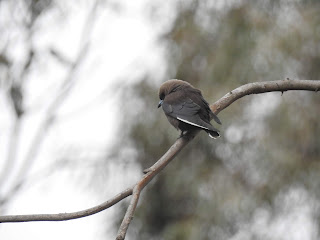Upon arrival at the site, I would always initially check the small section of shore around the entrance of the tunnel. Here various common waterbirds such as mallards, Eurasian coots, black-headed gulls and mute swans were abundant. Goosanders were also usually visible swimming further out in the lake, though the earliest of my visits provided stunning views of a male swimming very close to shore.
GOOSANDER
Mergus merganser
One visit also provided views of a large flock of gulls, which included birds I tentatively identified as Caspian gulls and European herring gulls, as well as a few common gulls. I have absolutely zero experience with European gulls though, so the exact accuracy of any identifications made is doubtful.
COMMON GULL
Larus canus
EUROPEAN HERRING GULL
Larus argentatus
After this I would then travel through the tunnel and into the forest on the other side of the lake. This forest was extremely birdy, full of pretty much all the garden birds I've mentioned earlier, along with many marsh tits, Eurasian wrens and my first middle spotted woodpecker.
MIDDLE SPOTTED WOODPECKER
Dendrocoptes medius
EURASIAN WREN
Troglodytes troglodytes
MARSH TIT
Poecile palustris
However, there were 2 main highlights.Firstly, Northern goshawks were very common in the forest, and I got views of goshawks on every single one of my visits.
NORTHERN GOSHAWK
Accipiter gentilis
Secondly, on 3 of my 4 visits I was stunned to get close views of Black woodpecker. On my second visit, while walking back a Black woodpecker amazed me as it fed right next to the path. On my following visits, I was gifted with further and equally stunning views. This site seems extremely reliable for the species, even though it is so close to inner Berlin.
BLACK WOODPECKER
Dryocopus martius
On one of my visits, I stumbled across a large flock of feeding finches, consisting of many siskins and serins.
SERIN
Serinus serinus
The lake itself was also full of birdlife. Grey herons and great white egrets searched for fish on the shore, and many goosanders, goldeneyes and a single velvet scoter fed further out. A long pipe was used as a perch by many great cormorants.
GOLDENEYE
Bucephala clangula
VELVET SCOTER
Melanitta fusca
GREAT WHITE EGRET
Ardea alba
Finally, I saw my life Common raven flying over the lake.
COMMON RAVEN
Corvus corax





























































